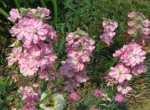 Common stock is a cool weather tender perennial native to coastal areas of southern Europe and a member of the cabbage family, Cruciferae, that also includes turnip, alyssum, and wall-flower. Stock grows 1-3′ tall and has oblong, gray-green leaves that are hairy and up to 4″ long. From late spring into fall in cool summers, or late fall and early spring in warm areas, very fragrant, single or double flowers appear in dense terminal racemes. They may be shades of pink, lavender, purple, white, yellow and red. Don’t expect to grow the long stemmed varieties you see in florist shops but be content with shorter versions that will give you just as much fragrance and a long vase life. And don’t expect a long vase life with no effort; stock fouls the water quickly and its water should be changed daily to get the most out of the flowers. If you decide to raise stock from seed don’t count on the double flowered kinds as 40% or more of seed grown stock can be expected to be single. The common name, stock, comes from the fact biennials or short-lived perennial, develop a woody bass/stock. The genus name, Matthiola, honors Pierandrea Mattioli (1500-1577), an Italian physician and botanist. The specific epithet, incana, is the Latin word meaning hairy and refers to the leaves.
Common stock is a cool weather tender perennial native to coastal areas of southern Europe and a member of the cabbage family, Cruciferae, that also includes turnip, alyssum, and wall-flower. Stock grows 1-3′ tall and has oblong, gray-green leaves that are hairy and up to 4″ long. From late spring into fall in cool summers, or late fall and early spring in warm areas, very fragrant, single or double flowers appear in dense terminal racemes. They may be shades of pink, lavender, purple, white, yellow and red. Don’t expect to grow the long stemmed varieties you see in florist shops but be content with shorter versions that will give you just as much fragrance and a long vase life. And don’t expect a long vase life with no effort; stock fouls the water quickly and its water should be changed daily to get the most out of the flowers. If you decide to raise stock from seed don’t count on the double flowered kinds as 40% or more of seed grown stock can be expected to be single. The common name, stock, comes from the fact biennials or short-lived perennial, develop a woody bass/stock. The genus name, Matthiola, honors Pierandrea Mattioli (1500-1577), an Italian physician and botanist. The specific epithet, incana, is the Latin word meaning hairy and refers to the leaves.
Type: Cool weather tender perennial, annual or biennial depending on the variety
Bloom: Single or double 1” wide flowers in white, pink, mauve, lavender, purple, and yellow in spring.
Size: 8-36” H x 10-12” W depending on the cultivar.
Light: Full sun.
Soil: Fertile, moist, well drained.
USDA Hardiness Zones: 7-10 but usually grown as an annual.
Care: Plant seedlings so that they have good air circulation and water so that leaves dry before nightfall; pinch young plants to encourage branching; deadhead to encourage flowering. Apply water soluble slow release fertilizer every 4 weeks.
Pests and Diseases: Susceptible to aphids, spider mites, white fly, leaf spot and powdery mildew.
Propagation: Seed.
Companion plants: Iris, rose, primrose, pansy, poppy, ornamental cabbage and kale.
Outstanding Selections: Cinderella series (10-12” tall; five colors; basally branched).
